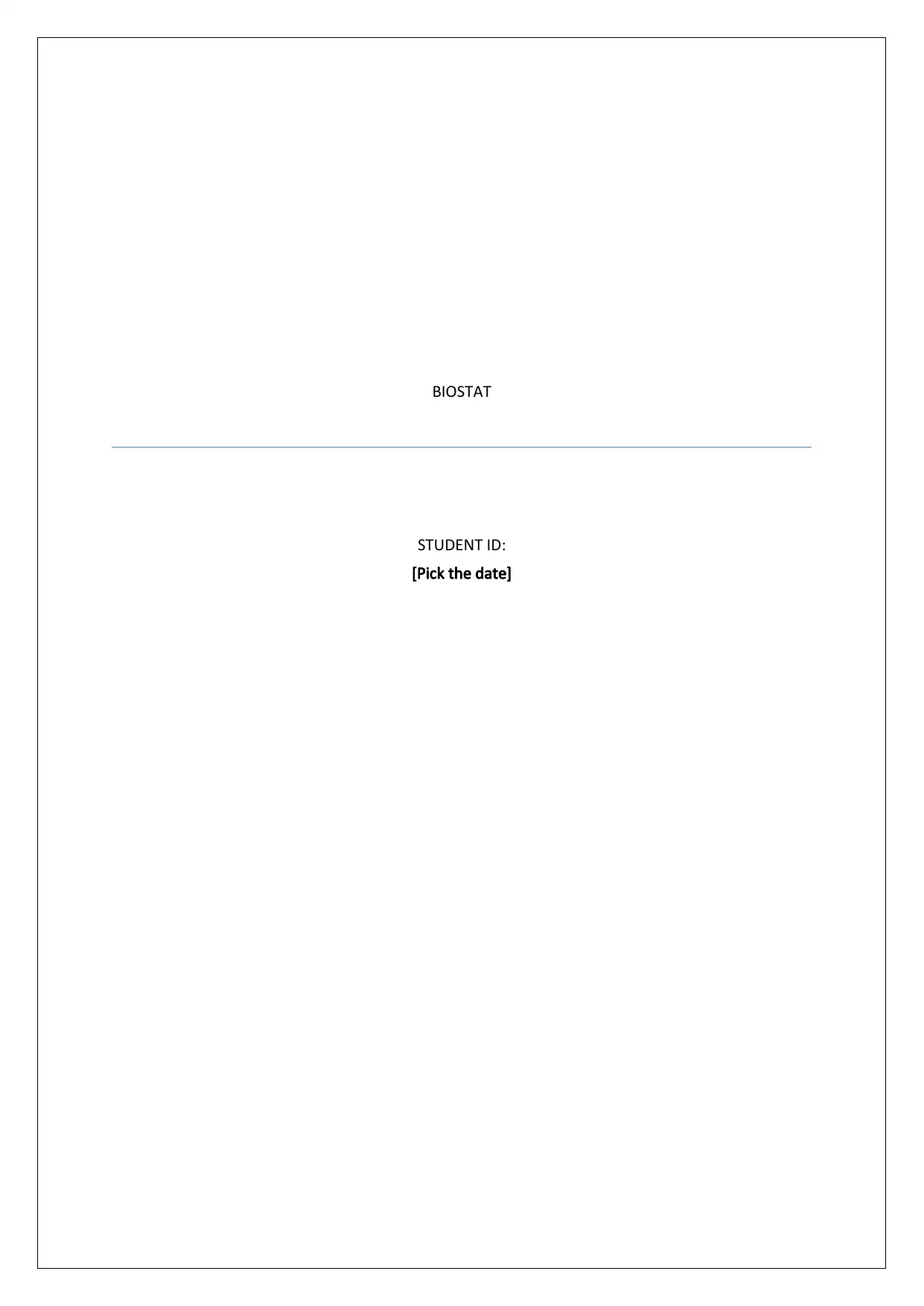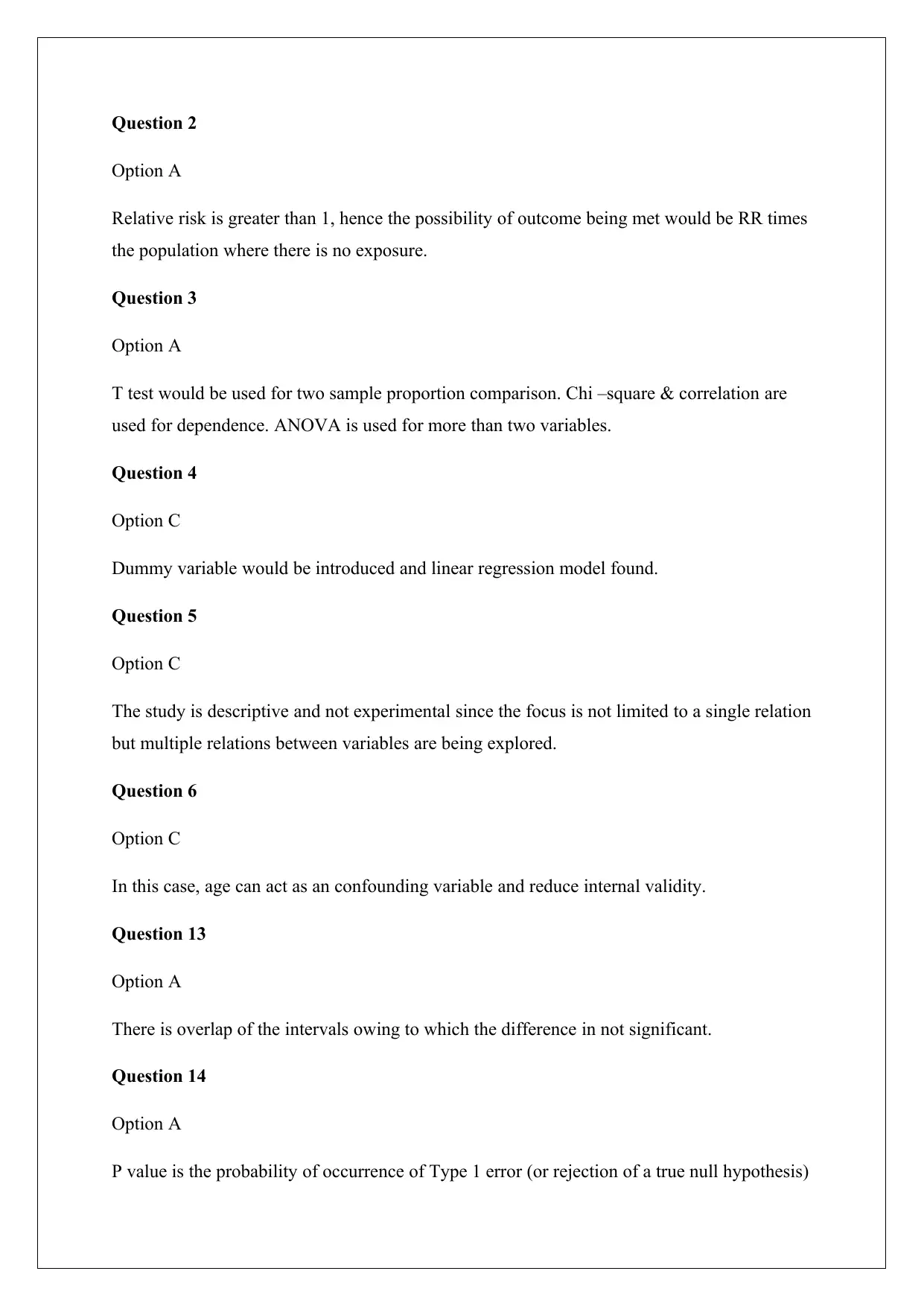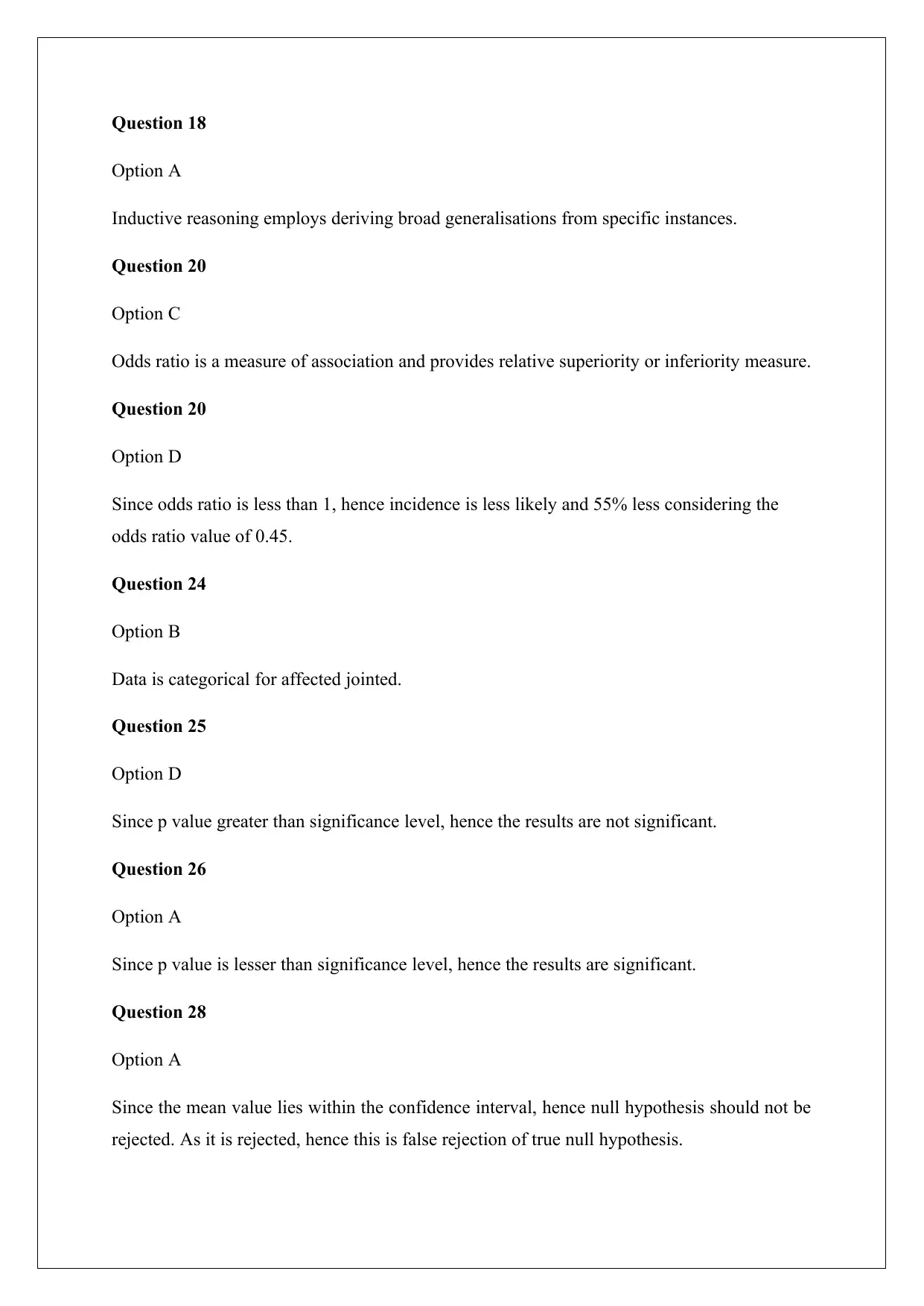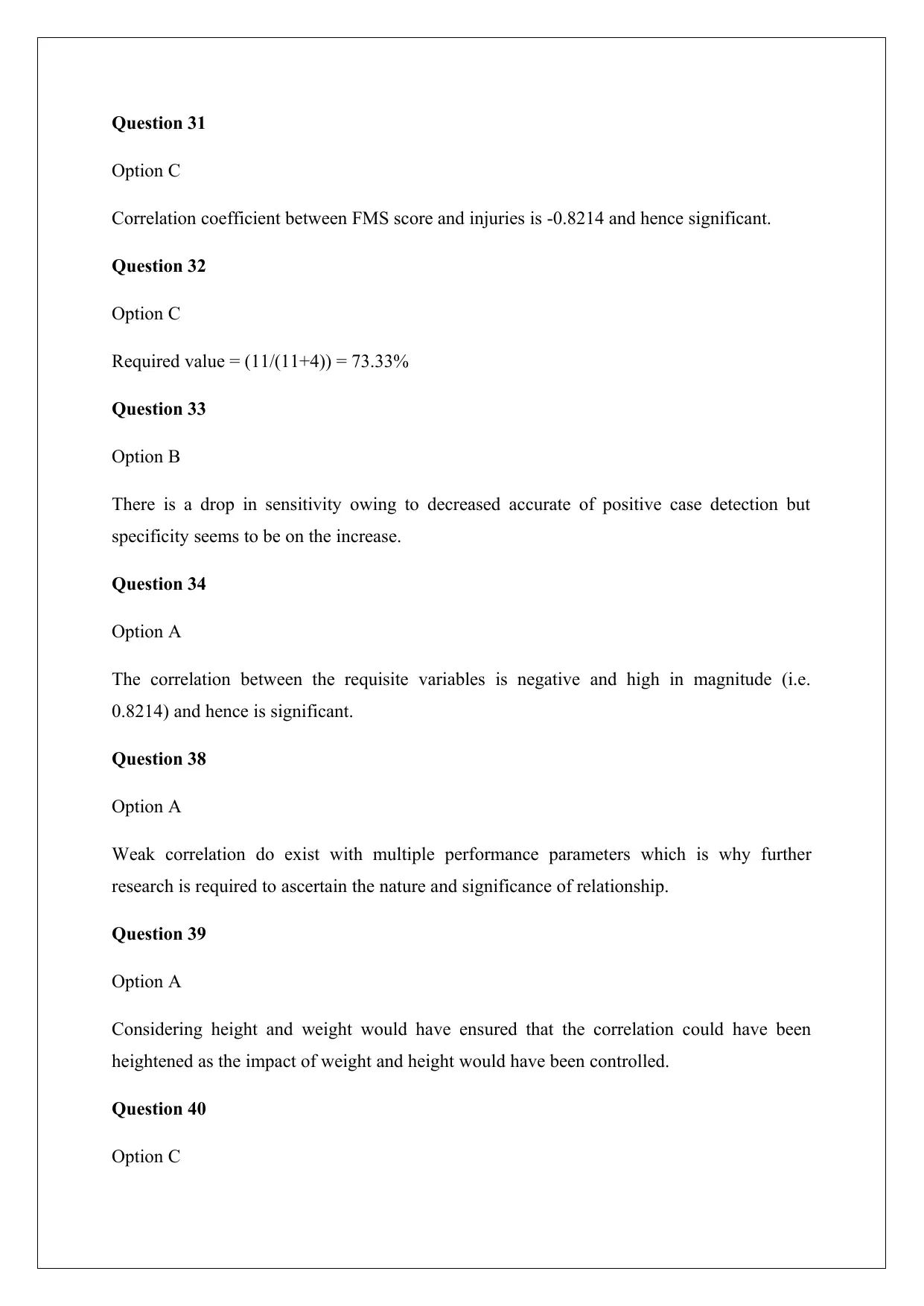Biostatistics: Assignment Solutions and Detailed Explanations
VerifiedAdded on 2023/05/28
|5
|593
|243
Homework Assignment
AI Summary
This document presents solutions to a series of biostatistics questions covering topics such as relative risk, hypothesis testing, study design, confounding variables, p-values, inductive reasoning, odds ratios, categorical data, correlation analysis, sensitivity and specificity, and statistical significance. ...

BIOSTAT
STUDENT ID:
[Pick the date]
STUDENT ID:
[Pick the date]
Paraphrase This Document
Need a fresh take? Get an instant paraphrase of this document with our AI Paraphraser

Question 2
Option A
Relative risk is greater than 1, hence the possibility of outcome being met would be RR times
the population where there is no exposure.
Question 3
Option A
T test would be used for two sample proportion comparison. Chi –square & correlation are
used for dependence. ANOVA is used for more than two variables.
Question 4
Option C
Dummy variable would be introduced and linear regression model found.
Question 5
Option C
The study is descriptive and not experimental since the focus is not limited to a single relation
but multiple relations between variables are being explored.
Question 6
Option C
In this case, age can act as an confounding variable and reduce internal validity.
Question 13
Option A
There is overlap of the intervals owing to which the difference in not significant.
Question 14
Option A
P value is the probability of occurrence of Type 1 error (or rejection of a true null hypothesis)
Option A
Relative risk is greater than 1, hence the possibility of outcome being met would be RR times
the population where there is no exposure.
Question 3
Option A
T test would be used for two sample proportion comparison. Chi –square & correlation are
used for dependence. ANOVA is used for more than two variables.
Question 4
Option C
Dummy variable would be introduced and linear regression model found.
Question 5
Option C
The study is descriptive and not experimental since the focus is not limited to a single relation
but multiple relations between variables are being explored.
Question 6
Option C
In this case, age can act as an confounding variable and reduce internal validity.
Question 13
Option A
There is overlap of the intervals owing to which the difference in not significant.
Question 14
Option A
P value is the probability of occurrence of Type 1 error (or rejection of a true null hypothesis)

Question 18
Option A
Inductive reasoning employs deriving broad generalisations from specific instances.
Question 20
Option C
Odds ratio is a measure of association and provides relative superiority or inferiority measure.
Question 20
Option D
Since odds ratio is less than 1, hence incidence is less likely and 55% less considering the
odds ratio value of 0.45.
Question 24
Option B
Data is categorical for affected jointed.
Question 25
Option D
Since p value greater than significance level, hence the results are not significant.
Question 26
Option A
Since p value is lesser than significance level, hence the results are significant.
Question 28
Option A
Since the mean value lies within the confidence interval, hence null hypothesis should not be
rejected. As it is rejected, hence this is false rejection of true null hypothesis.
Option A
Inductive reasoning employs deriving broad generalisations from specific instances.
Question 20
Option C
Odds ratio is a measure of association and provides relative superiority or inferiority measure.
Question 20
Option D
Since odds ratio is less than 1, hence incidence is less likely and 55% less considering the
odds ratio value of 0.45.
Question 24
Option B
Data is categorical for affected jointed.
Question 25
Option D
Since p value greater than significance level, hence the results are not significant.
Question 26
Option A
Since p value is lesser than significance level, hence the results are significant.
Question 28
Option A
Since the mean value lies within the confidence interval, hence null hypothesis should not be
rejected. As it is rejected, hence this is false rejection of true null hypothesis.
⊘ This is a preview!⊘
Do you want full access?
Subscribe today to unlock all pages.

Trusted by 1+ million students worldwide

Question 31
Option C
Correlation coefficient between FMS score and injuries is -0.8214 and hence significant.
Question 32
Option C
Required value = (11/(11+4)) = 73.33%
Question 33
Option B
There is a drop in sensitivity owing to decreased accurate of positive case detection but
specificity seems to be on the increase.
Question 34
Option A
The correlation between the requisite variables is negative and high in magnitude (i.e.
0.8214) and hence is significant.
Question 38
Option A
Weak correlation do exist with multiple performance parameters which is why further
research is required to ascertain the nature and significance of relationship.
Question 39
Option A
Considering height and weight would have ensured that the correlation could have been
heightened as the impact of weight and height would have been controlled.
Question 40
Option C
Option C
Correlation coefficient between FMS score and injuries is -0.8214 and hence significant.
Question 32
Option C
Required value = (11/(11+4)) = 73.33%
Question 33
Option B
There is a drop in sensitivity owing to decreased accurate of positive case detection but
specificity seems to be on the increase.
Question 34
Option A
The correlation between the requisite variables is negative and high in magnitude (i.e.
0.8214) and hence is significant.
Question 38
Option A
Weak correlation do exist with multiple performance parameters which is why further
research is required to ascertain the nature and significance of relationship.
Question 39
Option A
Considering height and weight would have ensured that the correlation could have been
heightened as the impact of weight and height would have been controlled.
Question 40
Option C
Paraphrase This Document
Need a fresh take? Get an instant paraphrase of this document with our AI Paraphraser

Descriptive statistics in the form of correlation analysis has been carried out but inferential
testing has not been performed.
Question 41
Option C
Question 46
Option B
Multiple regression required owing to multiple independent variables being present.
Question 47
Option A
P value is lower than significance level and hence significant difference.
Question 48
Option A
Independent t test ought to be conducted since the two variables are independent and
respective means are being compared.
Question 49
Option A
Owing to decrease of the standard deviations of the two variables, the standard error would
decrease and hence the test statistic value would increase and increasing the likelihood of null
hypothesis rejection.
testing has not been performed.
Question 41
Option C
Question 46
Option B
Multiple regression required owing to multiple independent variables being present.
Question 47
Option A
P value is lower than significance level and hence significant difference.
Question 48
Option A
Independent t test ought to be conducted since the two variables are independent and
respective means are being compared.
Question 49
Option A
Owing to decrease of the standard deviations of the two variables, the standard error would
decrease and hence the test statistic value would increase and increasing the likelihood of null
hypothesis rejection.
1 out of 5
Related Documents
Your All-in-One AI-Powered Toolkit for Academic Success.
+13062052269
info@desklib.com
Available 24*7 on WhatsApp / Email
![[object Object]](/_next/static/media/star-bottom.7253800d.svg)
Unlock your academic potential
© 2024 | Zucol Services PVT LTD | All rights reserved.





